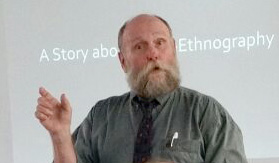
Meta-ethnography
Reporting Guidance



This post is written by Avril Nicoll, who attended the public lecture in Edinburgh where Professor George Noblit asked ‘How qualitative (or interpretive or critical) is qualitative synthesis, and what can we do about this?’)
What are we talking about?
Primary qualitative research in its many forms can help us understand how and why people experience the world in different ways. Qualitative synthesis is an umbrella term for methods used to bring reports of primary qualitative studies together. The aim of qualitative synthesis is to say more about a phenomenon than each included study could do on its own. Meta-ethnography is one approach to qualitative synthesis that researchers can draw on when designing a study.
Meta-ethnography was pioneered by George Noblit and Dwight Hare as an alternative to aggregative approaches which summed studies but failed to show what could be learnt from them. In 1988 Noblit and Hare published the seminal “little blue book”, Meta-Ethnography: Synthesizing Qualitative Studies. While this remains the foundation text, the context in which meta-ethnography is being designed and conducted is today very different, with researchers (as people) interpreting the principles – and how to put them into practice for different purposes – in different ways.
What’s the purpose of meta-ethnography?
Given that I am attempting a meta-ethnography as part of my PhD, I was fascinated to hear what George makes of developments in the field. He is passionate about synthesis methodology, and refreshingly relaxed about what people do with meta-ethnography as long as they are clear how they are going about it. However, as researchers help to construct ideas about society, he would prefer they use it for interpretation (to reveal taken-for-granted assumptions) and critique (to reveal how these are structured by power and ideology). This includes noticing what in the included studies could enable people to choose to do something more about their situation.
What are the implications of current practice?
George sees meta-ethnography as a way to talk about what we understand, in order to understand how we understand. He challenges some assumptions that (along with computer technology) are driving the current practice of meta-ethnography, comparing it to the tail wagging the dog and forcing research into a political discourse. These include that meta-ethnography:
George believes that misunderstandings of Noblit and Hare’s intentions have influenced what as well as how people have chosen to synthesise. As a result, if he was re-writing the book now, he would make two other methodological aspects of meta-ethnography clearer.
The first misunderstanding is that synthesis is literally of the ‘findings’ of included studies. Authors of a paper construct the whole account, and report their results in a way that fits this account. As there is more in accounts than the words say, there are clues for a synthesiser in the introduction, methods and conclusions sections as well as in the findings / results. George wishes he had used the term ‘storylines’ to show how synthesis can reveal what is not apparent in the individual stories alone. While the authors’ choice of themes can be used to explicate storylines, theme-to-theme synthesis is overly reductionist. George says it may therefore be appropriate to re-theme an account, “mess with” the authors’ interpretations, consider the connotations of terminology, and find the unacknowledged counter-stories.
The second misunderstanding is that the synthesis is about what is said in the accounts without considering the contexts in which they were produced. George sees this as “a real failure of our book”, as it is essential to add context to a synthesis that isn’t in the individual studies, such as what could or could not be said, the influence of time, geography, and professional cultures, or relationships between the researchers and the studies. “Even speculative context is helpful”, and he finds a historical perspective good for unpicking assumptions.
How can we contribute more through meta-ethnography?
The combination of storylines and context enables synthesisers to think about connections, and through this to understand mechanisms, which George believes is an essential contribution of a meta-ethnography. Acknowledging that observing and contemplating takes “forever” and can be “pretty boring”, he emphasises the need to play, to find ways to pay attention to what we are learning at each stage, and to notice what we may take for granted (for example by using a dictionary to consider older and newer meanings of words).
George proposes thinking of knowledge as a verb rather than a noun. This perhaps fits with his preference for using “I” in academic writing, a field that is more known for its pursuit of an abstract, formal tone through the use of nominalisations and third person. He also believes that a meta-ethnography should offer a comment on a field of study – including how knowledge gets constructed – and set a research agenda. In view of this, George suggests making it more participatory and accessible, with every step open to experiment, comparison and critique so we can discover what differences make a difference.
A video of the seminar will be posted here soon.

Monday, 16 May 2022 - Cochrane South Africa webinar on eMERGe reporting guidance 17 May 2022
Wednesday, 20 November 2019 - Meta-ethnography workshop comes to Belfast, N. Ireland
Thursday, 01 August 2019 - eMERGe reporting guidance now available in Spanish & Chinese!
View All